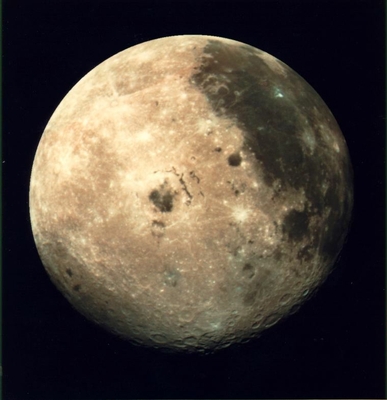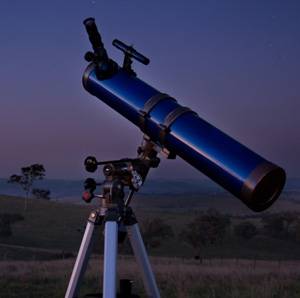
Tilt refers to the amount by which the Earth leans over in its orbit. Instead of being upright, with a line through the Earth from the North Pole to the South Pole making a right angle with the plane of the Earth’s orbit around the Sun, our planet is tilted at an angle of about 23 degrees out of the vertical. This tilt is responsible for the cycle of the seasons. The Earth always leans in the same direction in space, so as it goes round the Sun, first the Sun is on the side where one hemisphere is tilted towards the Sun and it is summer in that hemisphere and winter in the opposite hemisphere, then six months later the situation is reversed. The tilt also plays a part in the rhythms of Ice Ages.
Although the tilt of the Earth changes slightly on timescales of tens of thousands of years, it cannot vary very much, because the gravitational influence of the Moon acts as a stabiliser. If we did not have such a large moon, or if the Moon were much farther out from the Earth, the combined influence of the Sun and Jupiter (and to a lesser extent the other planets) would tug on the Earth and make it tumble in space, so that it might suddenly switch from being nearly upright to lying completely flat in its orbit (“suddenly”, on this timescale, meaning in as little as 100,000 years). Small changes in the various forces acting on the Earth would produce large and unpredictable effects. Just such chaotic tumbling has happened on Mars, where there is no large moon and where the tilt can change suddenly by at least 45 degrees, and more slowly by as much as 60 degrees. But on Earth, the tilt has been essentially constant for at least hundreds of millions of years, and probably a lot longer.
It doesn’t take much imagination to appreciate the effect on an incipient technological civilisation if the Earth suddenly rolled over on its side, with the North Pole, say, pointing directly at the Sun. The oceans and land around the equator would freeze over, and at high latitudes each hemisphere in turn would experience a sequence of searing summers followed by freezing winters. The equatorial regions would never thaw, even when the Earth was “side on” to the Sun in its orbit, because the shiny surface of ice and snow would reflect away most of the incoming solar heat. The tropics are, of course, home to the vast majority of species on Earth, most of which would go extinct. It seems that chaotic changes in tilt are normal for terrestrial planets, and this alone could be relevant for the emergence of a technological civilisation, or any kind of complex life based on land, on a planet that “just happens” to have a large moon.
As the Moon is slowly retreating from the Earth, this stabilising influence will decline as time passes, which sets a limit on the window of opportunity in which a civilisation like ours could have emerged on Earth. When the Moon formed, it was much closer to Earth, and has been steadily retreating as the energy of its orbital motion has gone into stirring up tides. At present it is moving outwards at a rate of about four centimetres per year, and within two billion years it will no longer be able to stabilise the Earth’s tilt. This ties in with one of the most curious coincidences in astronomy – indeed, in science – which seems to have no explanation and is utterly puzzling. Just now, the Moon is about 400 times smaller than the Sun, but the Sun is about 400 times farther away than the Moon, so that they look the same size on the sky. At the present moment of cosmic time, during an eclipse, the disc of the Moon almost exactly covers the disc of the Sun. In the past, the Moon would have looked much bigger and would have completely obscured the Sun during eclipses; in the future, the Moon will look much smaller from Earth and a ring of sunlight will be visible even during an eclipse. Nobody has been able to think of a reason why intelligent beings capable of noticing this oddity should have evolved on Earth just at the time that the coincidence was there to be noticed. It worries me, but most people seem to accept it as just one of those things.
Tides are less worrying, because they are well understood. And they must have played a significant part in the emergence of life from the sea and on to the land. Tides on Earth are primarily produced by the gravitational pull of the Sun and the Moon – in principle there are tiny effects from other planets, but too small to be noticed. Both the Sun and the Moon cause both the oceans and the solid Earth to bulge upwards underneath them and on the opposite side of the planet (you can think of the bulge on the far side as being related to a stretching of the Earth as it is tugged towards the Moon or Sun). In between, we have low tide. On their own, lunar tides today are about twice as big as solar tides. But the two tides add together or partially cancel at different times of the month. At New Moon and Full Moon, the Moon, Earth and Sun are in a straight line and the tides add together. This brings very high tides known as spring tides (because they “spring up”; nothing to do with the season spring). At the quarter moons, the Sun, Earth and Moon form a right angle, and the solar effect cancels out half of the lunar effect, producing much less impressive high tides, known as neap tides. Each place on Earth has two high tides and two low tides each day, as the Earth rotates under the Sun and Moon.
Even today, the ocean tides seem impressive, and in some ways it is even more impressive that tides in the “solid” Earth have an amplitude of about 20cm. The ground beneath your feet literally goes up and down over this range twice a day, but you don’t notice because you are going up and down with it. The solar influence has been constant as long as the Earth has been in its present orbit. But when the Moon was closer to the Earth, the tides it raised, both in the seas and in the solid Earth, were correspondingly larger.
Simulations of the event in which the Moon formed suggest that it coalesced out of a ring of debris no more than 25,000 km above the Earth, compared with its distance of just over 384,000 km today. That’s less than a tenth of the present Earth–Moon distance. This would have raised enormous tides in the oceans, if there had been any oceans at the time, but as it was the repeated stretching and squeezing of the solid Earth, associated with solid tides more than a kilometre in height, would have generated enough heat to keep the surface molten for some time after the impact. But the enormous amount of energy released would have seen the Moon move outwards relatively quickly, and things would have settled down enough for the Earth’s crust to form (or re-form) within a million years. Even so, the heat generated by lunar tides within the Earth would have remained significant, and contributed, along with the heat from radioactivity, to the establishment of tectonic activity on Earth.
 The Earth was also spinning much faster just after the impact that created the Moon – as a direct result of that impact. Tidal forces have slowed the spin of the Earth as the Moon has retreated from us. Just after the Moon formed, a day on Earth was only five hours long. At that time, instead of tides two metres high every 12 hours there would have been tides several kilometres high every two –and a half hours. But these extreme tides did not last long. The first reasonably complex forms of plant life on land emerged from the sea a little over 500 million years ago, and in a memorable numerical coincidence there were about 400 days in the year about 400 million years ago; so the emergence of complex life from the sea occurred when tidal conditions were not dramatically different from those of today. The plants, and later animals, that made the transition on to the land could do so by spreading out from the tidal zones. First they evolved the ability to survive drying out twice a day in the intervals between high tides, then some of them developed the ability to survive above the tide line altogether. This must have been a huge evolutionary advantage, giving them the ability to spread into and colonise vast areas where there were no predators. Of course, the predators soon followed!
The Earth was also spinning much faster just after the impact that created the Moon – as a direct result of that impact. Tidal forces have slowed the spin of the Earth as the Moon has retreated from us. Just after the Moon formed, a day on Earth was only five hours long. At that time, instead of tides two metres high every 12 hours there would have been tides several kilometres high every two –and a half hours. But these extreme tides did not last long. The first reasonably complex forms of plant life on land emerged from the sea a little over 500 million years ago, and in a memorable numerical coincidence there were about 400 days in the year about 400 million years ago; so the emergence of complex life from the sea occurred when tidal conditions were not dramatically different from those of today. The plants, and later animals, that made the transition on to the land could do so by spreading out from the tidal zones. First they evolved the ability to survive drying out twice a day in the intervals between high tides, then some of them developed the ability to survive above the tide line altogether. This must have been a huge evolutionary advantage, giving them the ability to spread into and colonise vast areas where there were no predators. Of course, the predators soon followed!
But would it all have happened so easily without the large tides associated with our large Moon?
Adapted from John Gribbin's latest book The Reason Why: The Miracle of Life on Earth, which was published in April by Allen Lane

